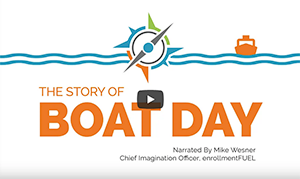During our travels across the wide landscape of U.S. higher education, we have seen many different types of admission teams. Some teams are clearly more effective than others. Not surprisingly, there is an obvious correlation between the effectiveness of the leader and his or her team. When leaders are not effective, they stifle the organization by placing a lid on the team’s abilities. When this lid is raised or removed, the possibilities for an organization to flourish are boundless.
The enrollmentFUEL staff recently started to observe organizational attributes within admission offices. We realized that they created a spectrum of behaviors that were easily clustered into descriptive categories. These categories were then compared against those institutions setting record enrollments. What quickly became apparent, in almost every situation, was that leaders largely determine a team’s success.
Our qualitative description of these five stages is shown below, ranging from the frenzied to the multipliers. There seems to be a continuum or hierarchy, that may remind you of Maslow’s hierarchy of needs, or in a more contemporary schema, that of Lencioni’s Five Dysfunctions of Teams. You will note that there is a strong correlation to Maslow’s theory, but only a visual similarity to Lencioni’s paradigm. As with Maslow’s theory, the five stages of an enrollment office can be divided into deficiency needs and growth needs, whereby the lower needs are met before progressing through the stages. What is equally interesting is that stages can be rapidly achieved or unraveled with leadership change.
The Frenzied
In this first stage of the continuum, the frenzied enrollment leader operates in a culture of fear and doesn’t feel protected. A frenzied leader leads a frenzied team. Leaders typically feel that they do not have the support of the administration. This feeling permeates the ethos of the office resulting in chaos and staff fatigue. This enrollment leader is often led by another frenzied leader, and the entire campus culture can be in need of repair. These leaders have a hard time prioritizing, and because of their stress level, can sometimes mistake busyness with effectiveness.
The Realizers
In an enrollment office’s journey to increasing organizational effectiveness, the team must first realize that they are frenzied and need to transform. In these organizations, we sometimes find a rebel who is willing to champion change. This transformation starts with developing a plan but requires a supportive administration for the change to have an impact. These realizers frequently leave the campus before investing the requisite time and energy that successfully propels the office to the next level. It is important, at this stage, to capture this newly found energy and use it to create a wave that others want to ride. What truly impacts this stage is the number of individuals who are onboard with affecting change.
The Believers
This is a team that has more than one realizer. Believers informally talk about things that they wish could be changed to make their team more effective. Believers are often comprised of a group of people who have been energized by attending a conference or event together. The team sometimes reaches this stage because someone new to the organization sees through a different lens and helps implement more effective operational approaches. Believers are often tenacious people who have hope, are passionate about the mission of the institution, are unwavering in their determination to get something done and have the political savvy to navigate difficult waters.
The Ralliers
This stage requires the development of a culture that is interested, and desirous of change. Team members are energized, have been given a path to success, and the resources to get there. Ralliers personify success by co-opting others to believe, and then rally, toward aspirational benchmarks of peer institutions. A group typically hits this stage when the team can align its energy with a well-defined vision, is in pursuit of something bigger than one believer, and is inspired to revive a formerly declining office environment or morale. The majority of current enrollment teams are composed of ralliers.
The Multipliers
These are enrollment offices that exhibit self-actualized characteristics. This team is typically comprised of individuals who thrive on developing others and have a mentoring or nurturing mindset. A hallmark of multipliers is their investment in the development of others. These offices often have a defined plan for staff members’ career trajectories and a leader who intentionally advocates on their behalf. Multiplying leaders want their division to thrive and can usually convince others of its importance. Offices comprised of multipliers have directors who are capable of serving as a vice president at a struggling school and can provide immediate success. These offices have numerous rising superstars, who at any time, could leave to take a job higher up the food chain. These offices are led by supervisors who foster and promote a culture of “up and out” and have a genuine interest in the professional growth of their staff. On the flip side, offices that are led by multipliers often maintain long-serving staff because they love their jobs and are embraced as institutional stakeholders in the team’s mission. Employees are loyal because they are valued by their supervisor and consistently have meaningful opportunities to contribute—and, are rewarded accordingly.
These five stages are usually but not always incrementally obtained in succession. They are often dramatically impacted by the leader on either end of the spectrum. Feelings of despair, consciousness raising, environmental reevaluation, counter conditioning, and team liberation are the primary outcomes of each stage. While a standard bell curve is represented in this descriptive continuum, there are fewer multipliers than there are frenzied organizations.
To help gauge where you and your team are on this continuum, please request our assessment by emailing support@enrollmentfuel.com. We can also make recommendations on a strategy to begin your journey along this self-improvement continuum—join the boundless.
Download Article
Related Articles
Mini-Case Studies Just Right for 2021
No one can dispute what an unpredictable, ambiguous, and upside-down year 2020 was. You may be...
Aligning New Board Members to Your Way of Thinking
Even before the upheavals caused by the global pandemic, college and university boards have...
From Clay to Gold: Leadership Lessons Among Chaos
“It was the best of times, it was the worst of times.” To me, it seems Charles Dickens described...





Leave A Comment